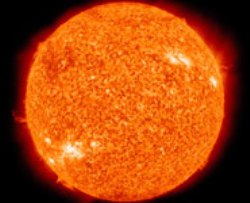Jun 24 2013
A project pursuing new approaches to harvesting thermal energy using nanodiamond has been awarded funding by the Engineering and Physical Sciences Research Council (EPSRC).
 NASA image of the sun
NASA image of the sun
Dr Neil Fox in the School of Chemistry led a successful bid for funding from EPSRC’s ‘Energy and the Physical Sciences’ initiative and has been awarded a grant of £951,947. The project, entitled ‘Beta-enhanced thermionic energy converters and nuclear batteries employing nanostructured diamond electrodes’, began in April 2013 and will run for 42 months. The project will continue the work initiated by E.ON’s International Research Initiative (IRI), ‘Diamond nanoparticle energy converter for highly efficient solar generation’.
Concentrated thermal energy can be harvested from numerous sources – including solar, geothermal and nuclear – and converted into electricity by a device called a thermionic energy converter. Such devices were being developed in the 1950s and 1960s as a means to power spacecraft and extract power from nuclear reactors, but they were constrained by a lack of suitable materials for efficient extraction of energy. This limited applications of the technology to those that could supply heat at temperatures exceeding 1200 degrees centigrade. But with the arrival of lithiated nanodiamond, developed at Bristol by the E.ON IRI project, a potential solution is in sight.
The project’s main aims are twofold:
- to maximise the benefits of this novel diamond material in a thermionic converter by combining it with plasmonic nanostructures to maximise the absorption of concentrated solar energy and its conversion into electrical current;
- to investigate how beta radiation generated by the Carbon 14 (14 C) contained within radioactive graphite can be used to improve the performance of thermionic diamond solar energy converters. The potential use of 14C in energy converters offers a cost-effective solution for the disposal of radioactive graphite that exists in the UK’s decommissioned Magnox and AGR reactors; the material could be recycled as a feedstock for a novel type of thermionic energy converter, called a Beta-enhanced Thermionic Diamond Converter (BTDC).
The project will bring together a strong interdisciplinary team: Dr Tom Scott and Dr Peter Heard from the Interface Analysis Centre (IAC); Professor Peter Flewitt from the School of Physics and the IAC; Professor Martin Cryan from Electrical and Electronic Engineering; and Professor Neil Allan from the School of Chemistry.
Professor Cryan will lead research into the modelling and fabrication of plasmonic absorbers on diamond for use with concentrated solar radiation; Dr Scott will lead activities to extract 14C material from Magnox graphite for incorporation into diamond materials; and Dr Fox will lead experimental and modelling activities on beta-enhanced thermionic diamond converters and nuclear batteries.
This research is expected to have wide-ranging applications in civil, military and space-borne power generation.